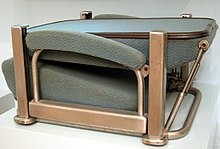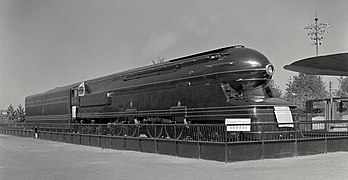Raymond Loewy
Raymond Fernand Loewy (born November 5, 1893 in Paris , † July 14, 1986 in Monaco ) was a French-American industrial designer and is considered one of the most important designers in the United States . Loewy is particularly known for its streamlined designs . Sometimes he was even called the inventor of the style, but this is demonstrably wrong.
Life
Loewy's parents were the journalist Maximillian "Max" Löwy (1860-1919) , who came from Vienna and grew up in France, and his wife Marie Labalme , who came from France . His grandparents were born in Hungary . From 1910 he studied engineering at the University of Paris . During the First World War , he served in the engineering corps and as a liaison officer to the American Expeditionary Forces and was awarded the Croix de guerre and the Commander's Cross of the Legion of Honor. After his parents died of the Spanish flu in 1919 , his two older brothers emigrated to the United States.
In September 1919 he followed them to the USA. They wanted to find him a job at General Electric . When during the crossing on the SS France the captain held an auction for the benefit of the families of shipwrecked sailors, he had nothing to offer and made an ink drawing of an attractive, modernly dressed passenger on the promenade deck. The bidder, the British Consul General in New York, Harry Gloster Armstrong, suggested that he work in commercial art work and recommended him to a magazine publisher friend in New York City.
He worked as a fashion draftsman for ten years. In 1929 he was hired by Gestetner to improve the appearance of a copier, the mimeograph . In the same year he became Art Director of the Westinghouse Electric Company before setting up his own design studio in 1930. From 1931 he designed Hupmobile and from 1936 to 1963 Studebaker . In 1938 Loewy became an American citizen .
The streamlined S1 steam locomotive from Loewy
The design of the GG1 series of the Pennsylvania Railroad (PRR) comes from Loewy
Studebaker Commander from 1953

The logos for the food company SPAR and the cigarette brand Lucky Strike , along with the streamlined S1 steam locomotive and the GG1 electric locomotive of the Pennsylvania Railroad (PRR), are the most famous shapes designed by Raymond Loewy. Loewy also designed numerous automobiles, for example for Studebaker and the Greyhound bus Scenicruiser from 1954, as well as the Shell shell .
One of his best-known design maxims and at the same time the title of his autobiography was Never leave well enough alone (never be satisfied with “That's enough”). In German the title ugliness sells badly . Another he called the “ MAYA principle ”, whereby the four letters stand for Most Advanced, Yet Acceptable (“extremely progressive, but still acceptable”).
Loewy worked in the 1950s for the porcelain - manufactory Rosenthal AG in Selb and created here with Richard S. Latham in 1954, among others, the classic service Rosenthal Form 2000 with many decors.

After the assassination attempt on John F. Kennedy , the office of Raymond Loewy was commissioned to design a commemorative stamp. He took the contract for $ 500 and designed the 5-cent John Kennedy stamp in 1964.
He designed a tractor for the Soviets.
In 1929 he met the Danish-American Jean Thompson, with whom he was married from 1931 to 1945. She later married the French Jacques Bienfait. In 1948 he married the PR consultant Viola Erickson (1922-1995), who brought a son into this marriage. With Erickson he had the daughter Laurence Loewy, who was born on August 3, 1953 and later worked as a journalist, screenwriter and TV producer. She died on October 15, 2008
After a major Raymond Loewy exhibition in Berlin in 1990, sponsored by the manufacturer of " Lucky Strike " from BAT-Cigaretten GmbH , the Raymond Loewy Foundation was set up in Germany . Similar foundations were later set up in other countries. The foundation awards the Lucky Strike Designer Award in Germany to prominent designers with an international background. A Lucky Strike Junior Designer Award is also presented annually. The Raymond Loewy Foundation serves the BAT Group as an integral part of the brand and PR strategy of "Lucky Strike".
Publications
- Never leave well enough alone. 1951, ( table of contents. )
- Ugliness sells badly. The experiences of the most successful designer of our time . Translated from the American by Hans Achim Weseloh, Econ, Düsseldorf 1953.
literature
- Angela Schönberger: Raymond Loewy. Prestel, Munich 1990, ISBN 3-7913-1449-1 .
- Charlotte Fiell, Peter Fiell: Design of the 20th Century . Taschen, Cologne 2000, ISBN 3-8228-4077-7 .
Movie
- The designer of the American Dream - Raymond Loewy. Documentary, France, 2017, 52:05 min., Script and direction: Jérôme de Missolz and Frédérique Bompuis, production: arte France, Les Films du Tambour de Soie, first broadcast: October 18, 2017 on arte, synopsis by ARD .
Web links
Databases
- Literature by and about Raymond Loewy in the catalog of the German National Library
- Raymond Loewy in the nndb (English)
- Raymond Loewy in the Internet Movie Database (English)
- Raymond Loewy Personal papers, 1903-1982. ( Memento of January 3, 2015 in the Internet Archive ) In: Hagley Museum & Library. Wilmington
- Raymond Loewy Archives. In: Hagley Museum & Library
Loewy portraits
- John Kobler: The Great Packager. In: Life , May 2, 1949, pp. 110-122, (English).
- Raymond Loewy - The Man Who Streamlined the Sales Curve. (German English)
- Loewy biography, mainly about Loewy as an automobile designer. In: text42.de
- RaymondLoewy.com (English)
From Loewy
Individual evidence
- ↑ death announcement Simon Löwy. in Neue Freie Presse February 9, 1873.
- ^ Raymond Loewy, American industrial designer. In: Munzinger archive . September 1, 1986, only the beginning of the article freely accessible.
- ↑ Raymond Loewy in the Notable Names Database (English)
- ^ Elmar Krekeler: The epochal design ideas of Raymond Loewy. In: The world . 5th November 2013.
- ↑ Thomas Seymat: Google celebrates Raymond Loewy, "father of industrial design". In: Euronews . November 4, 2013, (English).
- ↑ America's most famous electric locomotive in: Railway history special: Railways in New York, p. 62 ff.
- ↑ All decors of the Rosenthal Form 2000 series. In: alteserien.de , accessed on November 17, 2017.
- ^ Sarah Booth Conroy: Where is he now that Detroit knows it needs him? . In: Washington Post / The Tuscaloosa News , March 20, 1975.
- ↑ Milestones, Aug. 17, 1953. In: Time . August 17, 1953, (English), only the beginning of the article freely accessible.
- ↑ Remembering Laurence Loewy. In: studebakerclubs.com , (PDF; 1.8 MB), p. 9.
- ↑ Laurence Loewy - Obituary. In: legacy.com , / The Atlanta Journal-Constitution , October 19, 2008.
- ↑ Legacy Tobacco Documents Library (English) - font (in PDF , ≈ 85 kB) at the University of California, San Francisco (recorded there on December 22, 2004; accessed on November 5, 2013.)
| personal data | |
|---|---|
| SURNAME | Loewy, Raymond |
| ALTERNATIVE NAMES | Loewy, Raymond Fernand |
| BRIEF DESCRIPTION | Austrian-American industrial designer |
| DATE OF BIRTH | November 5, 1893 |
| PLACE OF BIRTH | Paris |
| DATE OF DEATH | July 14, 1986 |
| Place of death | Monaco |



